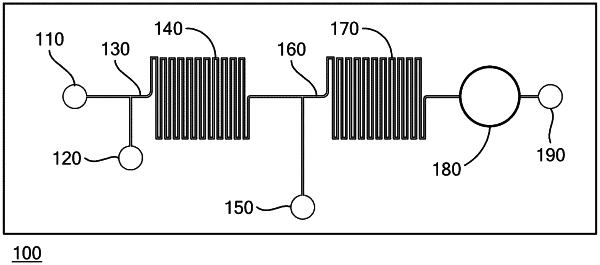| CPC G01N 33/54313 (2013.01) [B01F 25/4331 (2022.01); B01F 33/30 (2022.01); B01L 3/5027 (2013.01); B01L 3/502715 (2013.01); B01L 3/502761 (2013.01); B01L 3/502776 (2013.01); G01N 21/6428 (2013.01); G01N 33/5304 (2013.01); G01N 33/54366 (2013.01); B01L 2200/0605 (2013.01); B01L 2200/0647 (2013.01); B01L 2300/0654 (2013.01); B01L 2300/0816 (2013.01); B01L 2300/0867 (2013.01); B01L 2300/087 (2013.01); B01L 2300/0883 (2013.01); B01L 2400/0487 (2013.01); G01N 2021/6439 (2013.01); G01N 2201/061 (2013.01)] | 9 Claims |

|
1. A method of determining a concentration of an analyte in a liquid sample, the method comprising:
(a) providing:
(1) a microfluidic device for continuous flow optical detection of an analyte in a sample, the device comprising:
(i) first and second inlets;
(ii) a first microscale laminar flow channel fluidically connected to the first and second inlets such that liquids entering from the first and second inlets flow in a laminar manner through said first laminar flow channel;
(iii) a first microscale mixing channel fluidically connected to the first laminar flow channel such that liquid entering the first mixing channel from the first laminar flow channel is converted from laminar flow to non-laminar flow in said first mixing channel;
(iv) a second microscale laminar flow channel fluidically connected to the first mixing channel;
(v) a third inlet fluidically connected to the second laminar flow channel such that liquids entering the second laminar flow channel from the third inlet and the first mixing channel flow in a laminar manner in said second laminar flow channel; and
(vi) a second microscale mixing channel fluidically connected to the second laminar flow channel such that liquid entering the second mixing channel from the second laminar flow channel is converted from laminar flow to non-laminar flow in said second mixing channel;
(2) a liquid suspension of microspheres, wherein the microspheres are conjugated to a first analyte-binding agent;
(3) a liquid comprising a labeled second analyte-binding agent; and
(4) a liquid sample suspected of comprising said analyte; and
(b) flowing the liquid suspension of conjugated microspheres into the first inlet at a first flow rate;
(c) flowing the liquid sample into the second inlet at a second flow rate, whereby mixing of the conjugated microspheres and the liquid sample in the first mixing channel enables binding of analyte in the liquid sample to the first analyte-binding agent, resulting in formation of analyte-coated microspheres within the first mixing channel;
(d) flowing the liquid comprising the labeled second analyte-binding agent into the third inlet at a third flow rate, whereby mixing of the analyte-coated microspheres and the labeled second analyte-binding agent in the second mixing channel enables binding of the labeled second analyte-binding agent to the analyte that coats the conjugated microspheres, resulting in formation of microspheres coated with labeled second analyte-binding agent within the second mixing channel;
(e) detecting an amount of microsphere-bound label on individual microspheres as they flow through the second microscale mixing channel or after they exit the second microscale mixing channel and enter a translucent detector region; and
(f) determining a concentration of the analyte in the liquid sample based on a previously determined correlation between the amount of microsphere-bound label and concentration of the analyte.
|